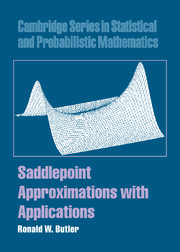Book contents
- Frontmatter
- Contents
- Preface
- 1 Fundamental approximations
- 2 Properties and derivations
- 3 Multivariate densities
- 4 Conditional densities and distribution functions
- 5 Exponential families and tilted distributions
- 6 Further exponential family examples and theory
- 7 Probability computation with p*
- 8 Probabilities with r*-type approximations
- 9 Nuisance parameters
- 10 Sequential saddlepoint applications
- 11 Applications to multivariate testing
- 12 Ratios and roots of estimating equations
- 13 First passage and time to event distributions
- 14 Bootstrapping in the transform domain
- 15 Bayesian applications
- 16 Nonnormal bases
- References
- Index
4 - Conditional densities and distribution functions
Published online by Cambridge University Press: 25 February 2010
- Frontmatter
- Contents
- Preface
- 1 Fundamental approximations
- 2 Properties and derivations
- 3 Multivariate densities
- 4 Conditional densities and distribution functions
- 5 Exponential families and tilted distributions
- 6 Further exponential family examples and theory
- 7 Probability computation with p*
- 8 Probabilities with r*-type approximations
- 9 Nuisance parameters
- 10 Sequential saddlepoint applications
- 11 Applications to multivariate testing
- 12 Ratios and roots of estimating equations
- 13 First passage and time to event distributions
- 14 Bootstrapping in the transform domain
- 15 Bayesian applications
- 16 Nonnormal bases
- References
- Index
Summary
Saddlepoint approximations for conditional densities and mass functions are presented that make use of two saddlepoint approximations, one for the joint density and another for the marginal. In addition, approximations for univariate conditional distributions are developed. These conditional probability approximations are particularly important because alternative methods of computation, perhaps based upon simulation, are likely to be either very difficult to implement or not practically feasible. For the roles of conditioning in statistical inference, see Reid (1995).
Conditional saddlepoint density and mass functions
Let (X, Y) be a random vector having a nondegenerate distribution in ℜm with dim(X) = mx, dim(Y) = my, and mx + my = m.With all components continuous, suppose there is a joint density f (x, y) with support (x, y) ε X ε ⊆ ℜm. For lattice components on Im, assume there is a joint mass function p (j, k) for (j, k) ε X ε ⊆ Im. All of the saddlepoint procedures discussed in this chapter allowboth X and Y to mix components of the continuous and lattice type.
Approximations are presented below in the continuous setting by using symbols f, x, and y. Their discrete analogues simply amount to replacing these symbols with p, j, and k. We shall henceforth concentrate on the continuous notation but also describe the methods as if they were to be used in both the continuous and lattice settings. Any discrepancies that arise for the lattice case are noted.
- Type
- Chapter
- Information
- Saddlepoint Approximations with Applications , pp. 107 - 144Publisher: Cambridge University PressPrint publication year: 2007



